Physical Model Research on the Impact of Bridge Piers on River Flow in Parallel Bridge Construction Projects
Abstract
1. Introduction
2. Materials and Methods
2.1. Study Reaches
2.2. Overview of Typical Projects
2.3. Research Methodology
2.4. Similarity Criterion and Control Scale
| Similarity condition of sediment-laden flow: | |
3. Results
3.1. Validation of the River Engineering Model
- (1)
- Validation of hydrodynamic drag similarity: The test used the measured pre-flood topography of the test river section in April 2021 as the initial topographic data, the water and sand process from April to October 2021 as the test water and sand process (Figure 3), and the measured water level and flow process of the water level and flow of the test section at the Lokou Hydrological Station as the model export control conditions for the verification test. By comparing the measured water level of the model with the measured water level of the prototype at the flow rate of 600 m3/s across five sections (Caojiaquan, Xidaokou, Lijiaan, Lujiazhuang, and Zhengjiadian; see Figure 5), the maximum error is 0.22 m, and the average error is 0.13 m. The results show that the model water level and the flow pattern are basically consistent with the prototype, reflecting that the model meets the drag similarity and flow regime similarity.
- (2)
- Verification of riverbed deformation similarity: This is a comparison of a cross-section of 24 topographic data measurements (see Figure 6). Using the cross-section method to calculate the verification of the prototype and model siltation volume of the river section, we achieve a prototype cumulative scour volume of 39.52 × 105 m3, and a model cumulative scour volume of 32.14 × 105 m3. By calculating the ratio of the difference between the sedimentation and erosion volumes in the model test and those in the prototype river reach to the sedimentation and erosion volume in the prototype, the relative error was determined to be −18.68%. The error is in the permissible range, which indicates that the model siltation topography is basically consistent with the prototype [24], reflecting that the model meets the similarity of river bed deformation. The validation of the model shows that the results of the model can simulate the water and sand movement characteristics of the actual river channel.
3.2. Analysis of Changes in River Conditions After Construction of Parallel Bridges
3.2.1. Characterization of River Conditions Prior to Merging Bridges
3.2.2. Characteristics of Changes in River Potential After Merging Bridges
3.3. The Influence of the Parallel Bridge Construction on the Flood Level of the River Channel
3.3.1. Analysis of Along-Channel Water Levels Under Different Flow Conditions
3.3.2. Backwater Analysis of Bridge Upstream Face
3.3.3. Analysis of Water Level Variations Along the Path
3.4. Determination of the Optimal Number of Cloud Droplets
3.5. Study of the Impact of Flood Processes on Riverbanks and Beach Lips
4. Discussion
5. Conclusions
- (1)
- The hydraulic physical model constructed in this paper is basically consistent with the measured data in simulating the water level difference between the upstream and downstream of the bridge group river section, the average cross-sectional flow velocity, and the flow pattern of the river section. The relative error in sediment deposition simulations is within 20%, confirming the model’s suitability for such studies.
- (2)
- Characteristics of river regime changes near the bridge location after parallel construction of bridges: The river course is basically stable, with the overall flow dynamics constrained by existing bank protection projects. The new bridge has a negligible impact on the reach-scale river regime. The main river line of the river course, which is typically meandering, generally follows the evolutionary pattern of “straightening with high water and curving with low water.”
- (3)
- Characteristics of water level rises in front of the bridge after parallel construction of the bridge: As the flow increases, the flood discharge section gradually expands. When the flow exceeds 5000 m3/s, the flood begins to overflow onto the banks and is affected by the backwater effect of the newly constructed bridge. Under the 10-year design flood, the water level difference between the upstream and downstream observation sections adjacent to the bridge pier changed from 5 cm before the construction of the parallel bridge to 9 cm after construction, representing an 80% increase in the backwater effect. Under the 20-year design flood, the water level difference between the two measurement points changed from 7 cm before the construction of the parallel bridge to 12 cm after construction, indicating a 71% enhancement in the backwater effect.
- (4)
- Characteristics of the waterback length of water levels in front of the bridge after merging: As the flow increases, the backwater distance extends upstream. At the flow rate of a 10-year design flood, the backwater effect can reach about 3000 m upstream of the bridge site; when it is at the flow rate of a 20-year design flood, the affected area extends to about 3500 m.
- (5)
- Characteristics of flow velocity changes near the bridge location after a parallel construction of bridges: The flow velocity in the cross-section before and after the bridge decreased to a certain extent compared to before the bridge, and the distribution pattern of flow velocity across the sections is consistent. In the main channel area, the flow velocity generally increases, with the maximum change in flow velocity being 0.25 m/s; in the floodplain area, the flow velocity fluctuates significantly, and under characteristic flood conditions, the change in flow velocity in areas with dense bridge piers is greater than in areas with sparse piers, with the maximum difference in flow velocity in the floodplain area reaching 0.3 m/s.
- (6)
- Impact characteristics of the flood processes on changes in the riverbank: Significant bank erosion has been observed in the left bank shoal area of the bridge layout, causing the main channel to widen. It is necessary to further strengthen the monitoring of the bank area to protect the resources of the shoal area. After the flooding process, the river channel tends to evolve into a U-shaped channel, and measures should be taken to strengthen the protection of the piers at the junction of the floodplain and the channel.
- (7)
- Based on the test results, it is advisable to install diversion facilities at the most affected piers (Piers 116 and P5 of the new bridge) to modify local flow dynamics, and thus, safeguard pier safety and mitigate localized backwater effects.
Author Contributions
Funding
Institutional Review Board Statement
Informed Consent Statement
Data Availability Statement
Acknowledgments
Conflicts of Interest
References
- Ye, D.S.; Zhang, M.; Fan, B.L. Principles and Practice of Bridge Pier Design, 1st ed.; Yellow River Water Resources Press: Zhengzhou, China, 2004; ISBN 9787806217320. [Google Scholar]
- Wu, S.Q.; Xue, W.Y.; Wu, X.F.; Zhou, J.; Dai, J.; Pang, C. Quantitative Study on Superposition Effect of Bridge Group Water Resistance in Urban Flood Channels. Yellow River 2019, 41, 96–102. [Google Scholar] [CrossRef]
- Xu, D.; Yang, H.T.; Wang, D.; Ji, C.; Bai, Y.; Ji, Z. Numerical Simulation Study on Backwater Characteristics of Oblique Bridge Piers in River Channels. J. Hydroelectr. Eng. 2018, 37, 55–63. [Google Scholar] [CrossRef]
- Yan, J.; Cai, X.H.; Lu, P.; Chen, Z.W. Model Test Study on Backwater of River-Crossing Orthogonal Bridge Piers. J. North China Univ. Water Resour. Electr. Power 2021, 42, 60–67. [Google Scholar] [CrossRef]
- Xie, J.H. River Simulation; Water Resources and Electric Power Press: Beijing, China, 1990; ISBN 9787120010386. [Google Scholar]
- Wang, G.Q. Research Progress on River Sediment. J. Sediment Res. 2007, 2, 64–81. [Google Scholar] [CrossRef]
- Luan, W. Numerical Simulation Analysis of the Impact of Bridge Construction on River Flow. Water Conserv. Sci. Technol. Econ. 2022, 10, 63–67. [Google Scholar] [CrossRef]
- Wang, Z.J. Numerical Simulation of Flow Field and Erosion-Deposition Characteristics of Bridge Group Section in Yixian Urban Area of Daling River. Master’s Thesis, Shenyang Agricultural University, Shenyang, China, 2016. Available online: https://kns.cnki.net/kcms2/article/abstract?v=upp0mjVwiKUK0Y08wr51Khdsni3o95h3CVBQ-fm0SA5z5R6jEUuz5ZCAAFc1W4TLtMQM_swA9u2wKU0OAsqhQ7vgL1n2LIqnEY_E6nJ9OTatxBYx3oY5kI3l00u9RmAwMQcRQ4XqIiMPvYIO_5q1J8pihOpjVxu6J0K6tadEsJArKjks6WE1AhXgjqFpy7xeQnoNDZ2XoeQ=&uniplatform=NZKPT&language=CHS (accessed on 1 June 2025).
- Wu, S.Q.; Guo, N.; Wu, X.F.; Zhou, X.H.; Zhao, Y.; Xue, W.Y. Research on the Impact of the Superimposed Water-Blocking Effect of Bridge Groups on the River Flow Capacity. Jiangsu Water Resour. 2019, 6, 1–6. [Google Scholar] [CrossRef]
- Li, Y.F.; Lü, X.Y.; Xu, H.; Wang, X.J.; Du, D.J. Generalized Study on the Cumulative Impact of Water-Crossing Bridge Groups on River Hydrodynamic Forces. J. Waterw. Harb. Eng. 2024, 3, 34–41. [Google Scholar] [CrossRef]
- Yu, H.; Shang, H.; Sun, W.M. Numerical Simulation Analysis of the Influence of Long-Span Bridge Piers on River Flow Regime. Shandong Water Resour. 2022, 51–52+55. [Google Scholar] [CrossRef]
- Chen, J.; Hou, L.T.; Liang, Y.J.; Zhao, Y.; Yu, M.H. Influence of Bridge Construction on Water Flow Movement in Different Characteristic Reaches of the Middle and Lower Yangtze River. Eng. J. Wuhan Univ. 2012, 45, 340–344+355. Available online: https://kns.cnki.net/kcms2/article/abstract?v=TD_mLQSGK6s312hiVJyuTeGBgyDn32A4hKqY19wuDzg2VXf6vzyhfOJNr977C19xxlb83isGtmaRw3JBF5Uh3GlXfypaCWbFxCjb0FJ3b5rhve5sPhMuyeijH4lZ8arN-QeYgLWiWr1RZLwhBv1-o-KMy_LEhWvxV9Mzmg1rJIqGRyiyL4b8ToSbxRPkE33C&uniplatform=NZKPT&language=CHS (accessed on 1 June 2025).
- Jiang, F. Impact of Pier Layout Forms on the Hydraulic Characteristics of Bend Flow. Master’s Thesis, Hebei University of Engineering, Handan, China, 2021. [Google Scholar] [CrossRef]
- Luo, W.G.; Lu, J.; Lai, H.; Fan, Y.Z. Research on Backwater in Front of Piers of Multiple Parallel Bridges with Short Distances. J. Sichuan Univ. (Eng. Sci. Ed.) 2015, 47, 6–13. [Google Scholar] [CrossRef]
- Wang, K.; Fu, X.D.; Wang, G.Q. Comparison of Calculation Methods for Bridge Pier Backwater. South–North Water Divers. Water Sci. Technol. 2006, 6, 53–55. [Google Scholar] [CrossRef]
- Biglari, B.; Sturm, T.W. Numerical Modeling of Flow around Bridge Abutments in Compound Channel. J. Hydraul. Eng. 1998, 124, 156–164. [Google Scholar] [CrossRef]
- Seckin, G.; Atabay, S. Experimental Backwater Analysis around Bridge Waterways. Can. J. Civ. Eng. 2005, 32, 1015–1029. [Google Scholar] [CrossRef]
- Richardson, J.E.; Panchang, V.G. Three-Dimensional Simulation of Scour-Inducing Flow at Bridge Piers. J. Hydraul. Eng. 1998, 124, 530–540. [Google Scholar] [CrossRef]
- Shafieifar, M.; Farzad, M.; Azizinamini, A. New Connection Detail to Connect Precast Column to Cap Beam using Ultra-High-Performance Concrete in Accelerated Bridge Construction Applications. Transp. Res. Rec. 2018, 2672, 207–220. [Google Scholar] [CrossRef]
- Biswas, S.S.; Pani, P. Changes in the hydrological regime and channel morphology as the effects of dams and bridges in the Barakar River, India. Environ. Earth Sci. 2021, 80, 1–20. [Google Scholar] [CrossRef]
- Biswas, M.; Raha, A.; Roy, S. Impacts of bridge constructions on channel dynamics and sediment aggradation: An integrated discussion, West Bengal, India. Geomatica 2024, 76, 100021. [Google Scholar] [CrossRef]
- Zheng, M.; Xue, L.J.; Lu, C.B. Comprehensive Flood Control Evaluation and Management Measures for the Super Large Bridge Project on Dagu River. Shandong Water Resour. 2022, 8, 81–82. [Google Scholar] [CrossRef]
- Zhang, Y.; Xing, C.X. Research on Sediment Selection and Verification Test of Movable Bed Model in Xiaolangdi Reservoir Dam Area. J. North China Univ. Water Resour. Electr. Power (Nat. Sci. Ed.) 2016, 37, 40–44. [Google Scholar] [CrossRef]
- Liu, X.; Liu, Y.Z. Study on the Applicability of Two Sediment Carrying Capacity Formulas in the Wandering Reach of the Yellow River. Water Resour. Power 2020, 38, 24–27. [Google Scholar] [CrossRef]
- Liu, Y.H.; Su, N.H. Analysis of the Influence of Bridge Construction on the River Regime of the Yellow River in Heze. Yellow River 2024, 46, 25–26. [Google Scholar]
- Yao, W.Y.; Wang, W.D. Study on the adjustment of river regime at the wandering reach of the lower Yellow River. Adv. Water Sci. 2006, 17, 624–630. [Google Scholar] [CrossRef]
- Wang, Y.; Ji, R.C.; Wang, G.H.; Fang, S.H. Relationship between Water Resistance and Backwater Characteristics of Skew Bridge Piers. Water Resour. Power 2025, 43, 80–83+20. [Google Scholar] [CrossRef]
- Xie, Z.Z.; He, J.; Han, Y.F. Preliminary Study on Water Resistance Effect of Different Pier Combinations. Jiangsu Water Resour. 2024, 8, 6–11. Available online: https://link.cnki.net/doi/10.16310/j.cnki.jssl.2024.08.009 (accessed on 1 June 2025).
- Ran, R.; Liu, Y.F. Analysis of the Influence of Reservoir Bank Slope Morphology on Its Stability Using the BSTEM Model. Ground Water 2011, 33, 162–165. [Google Scholar] [CrossRef]
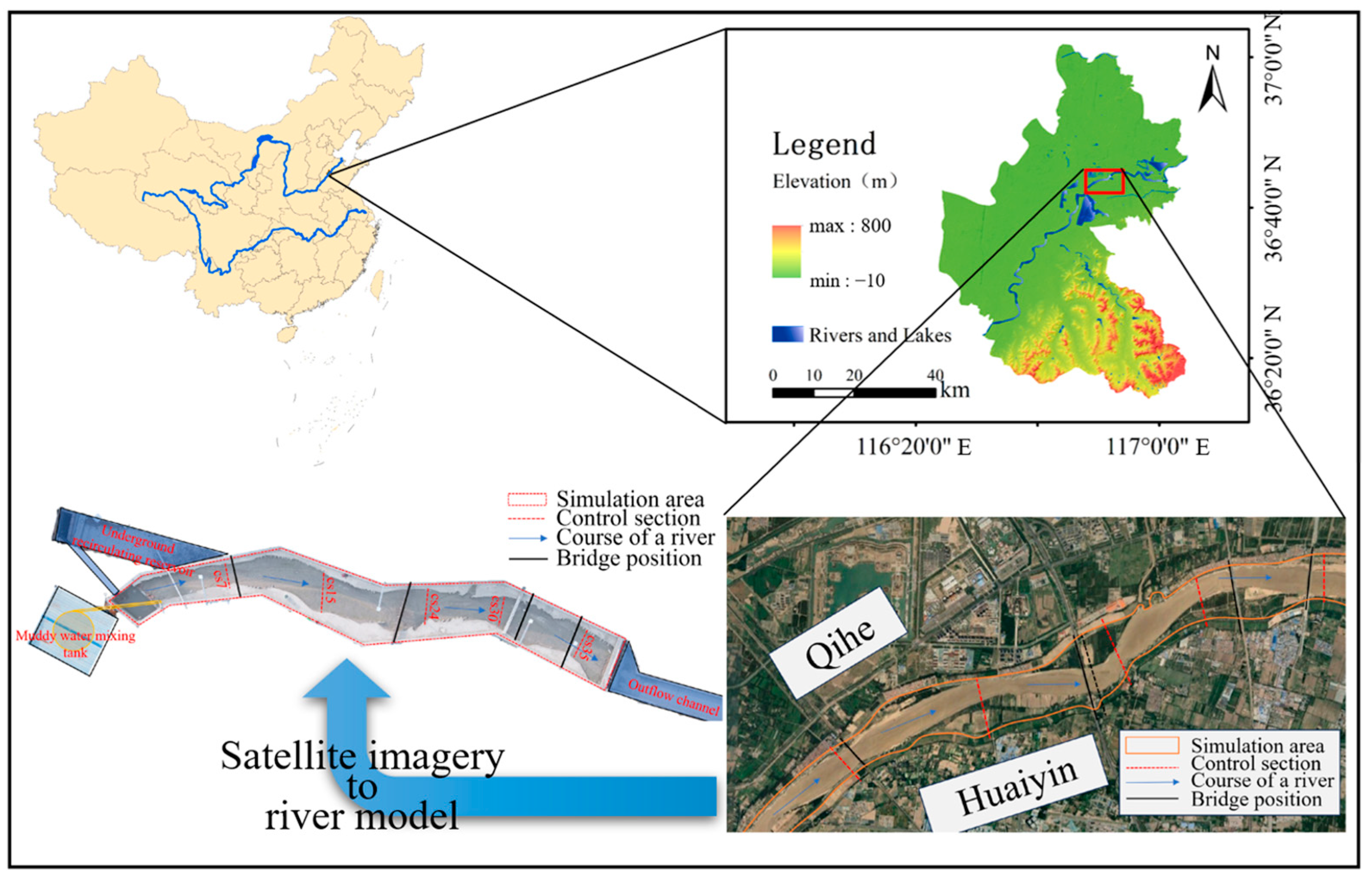



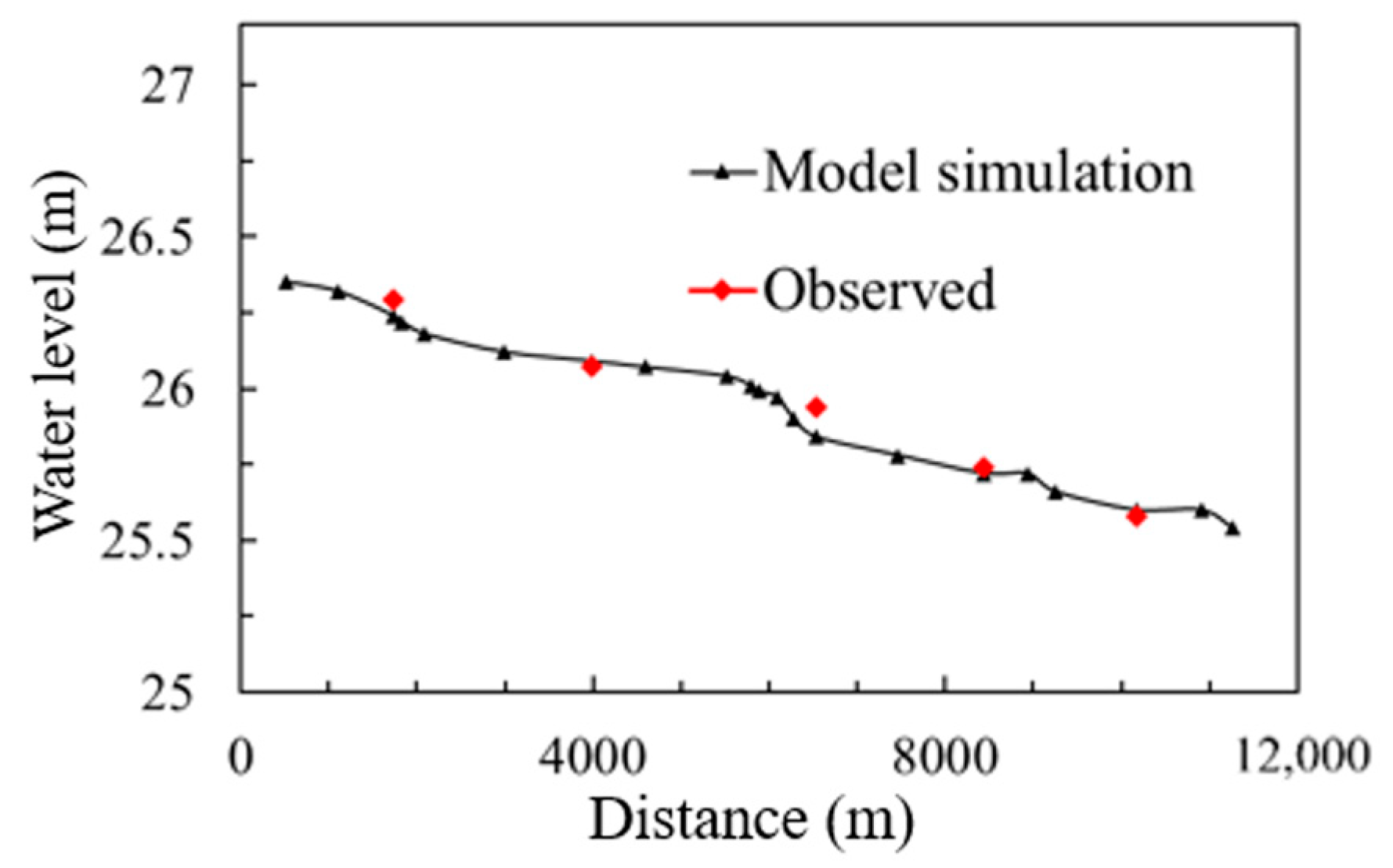

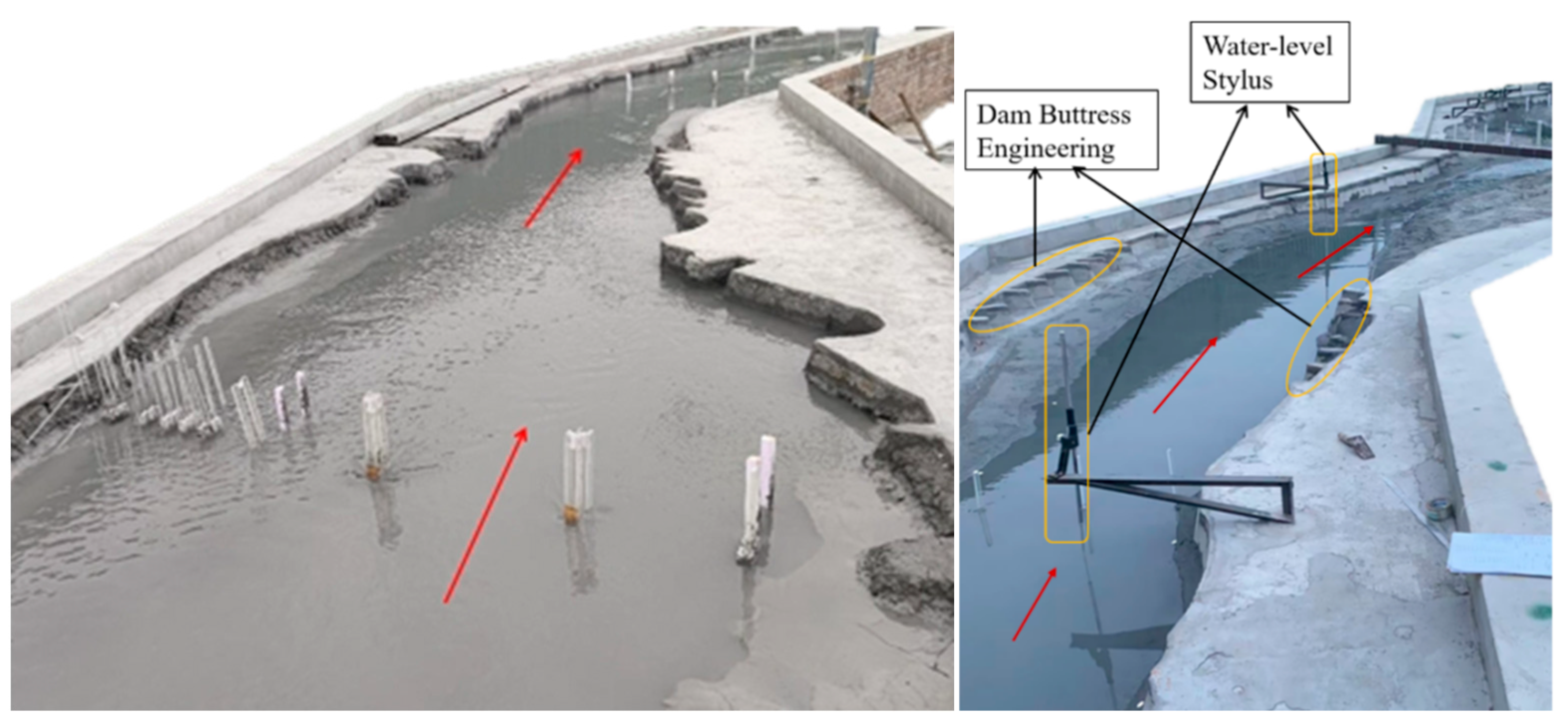
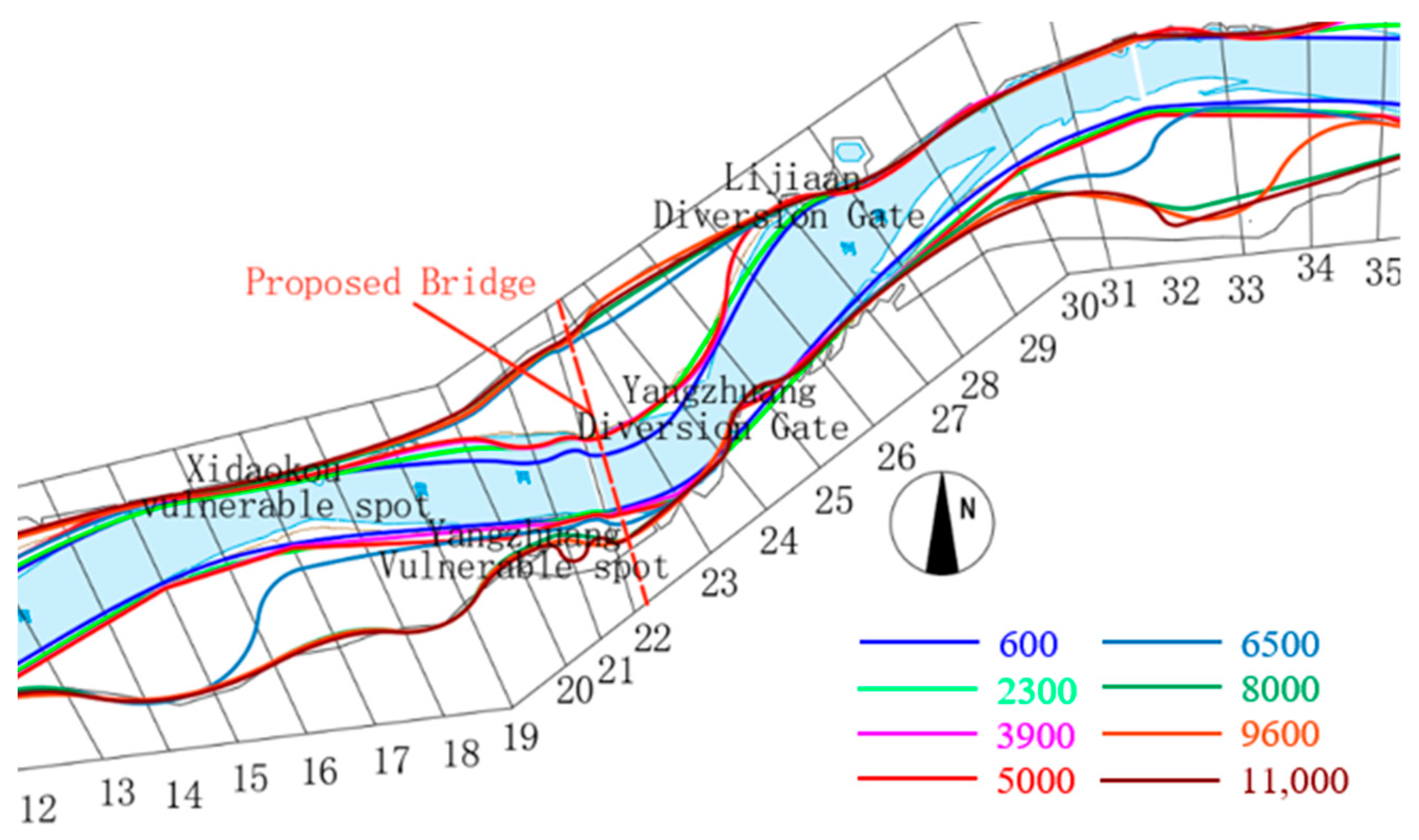
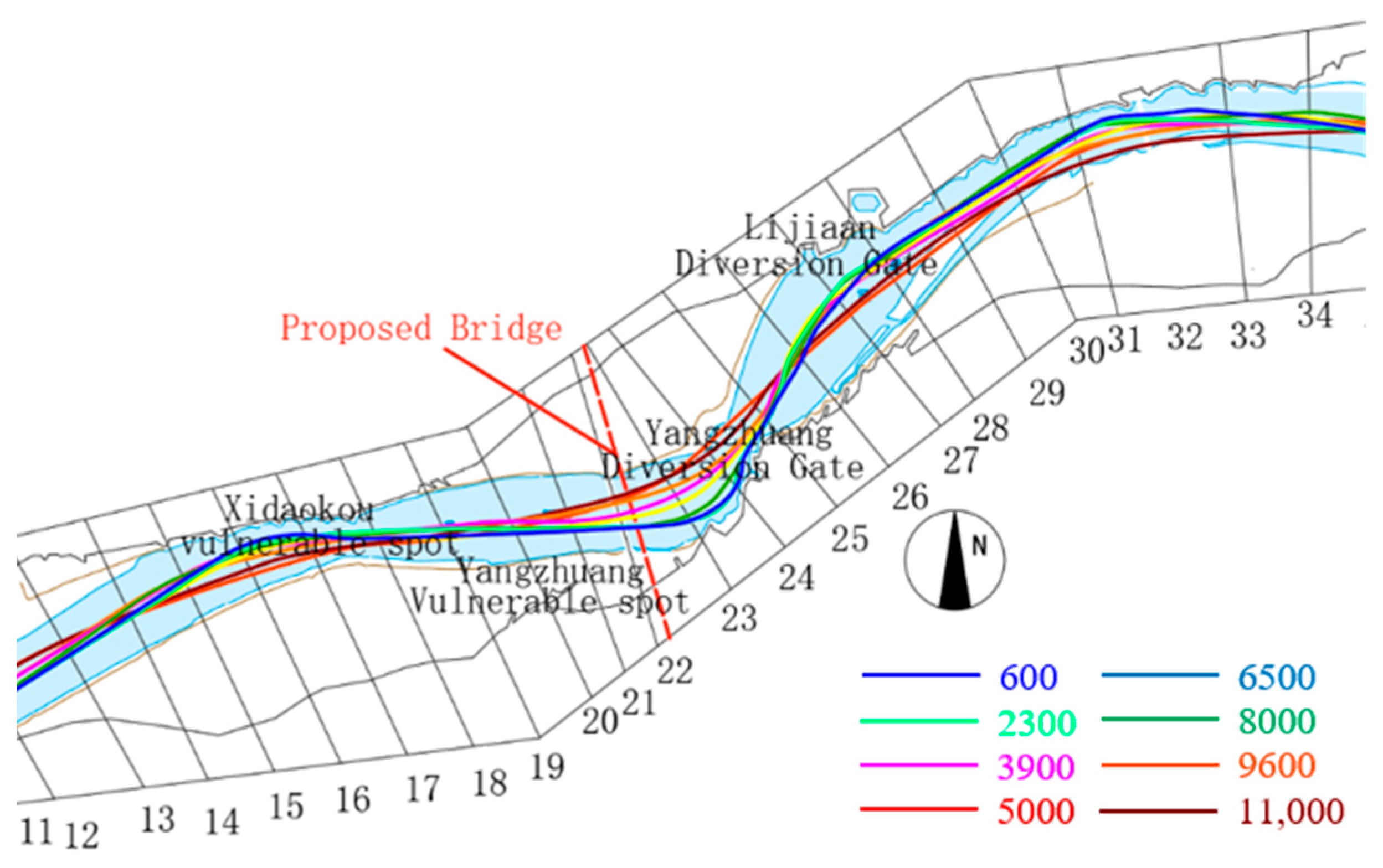
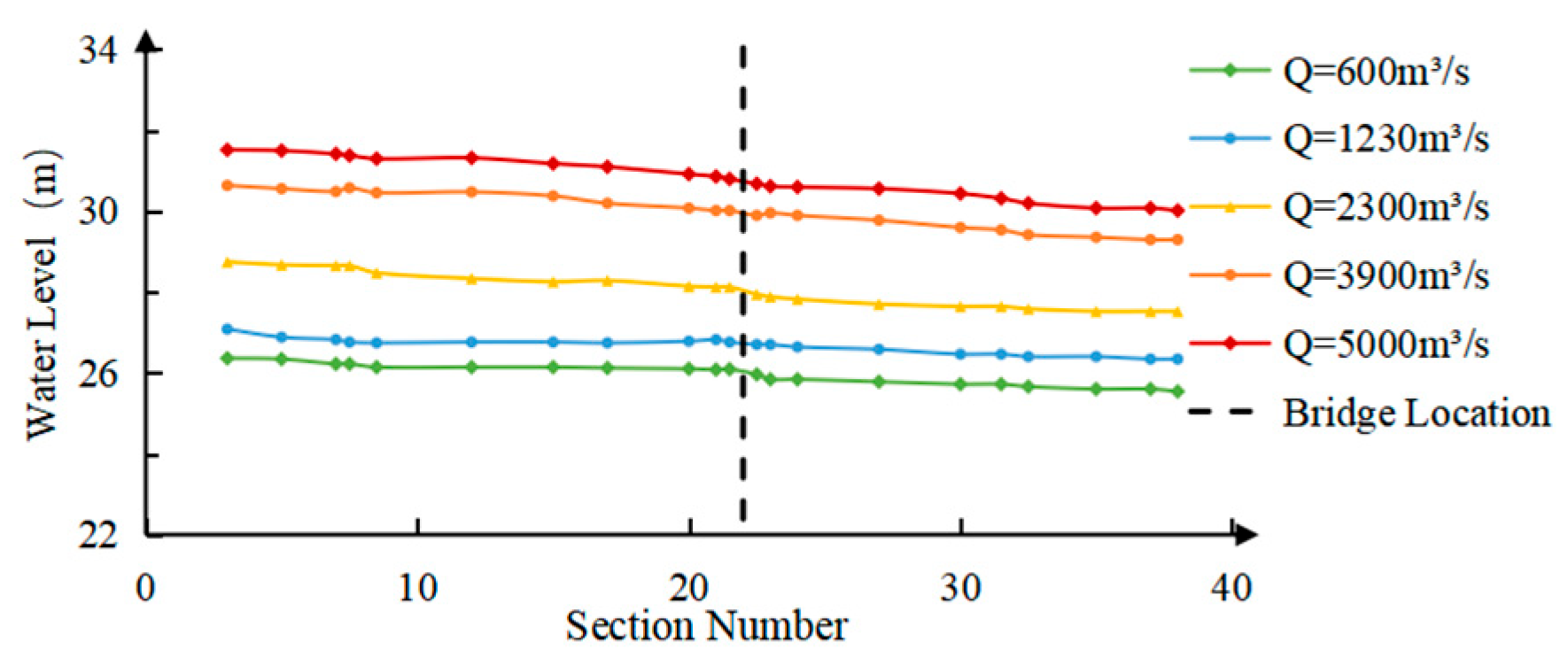

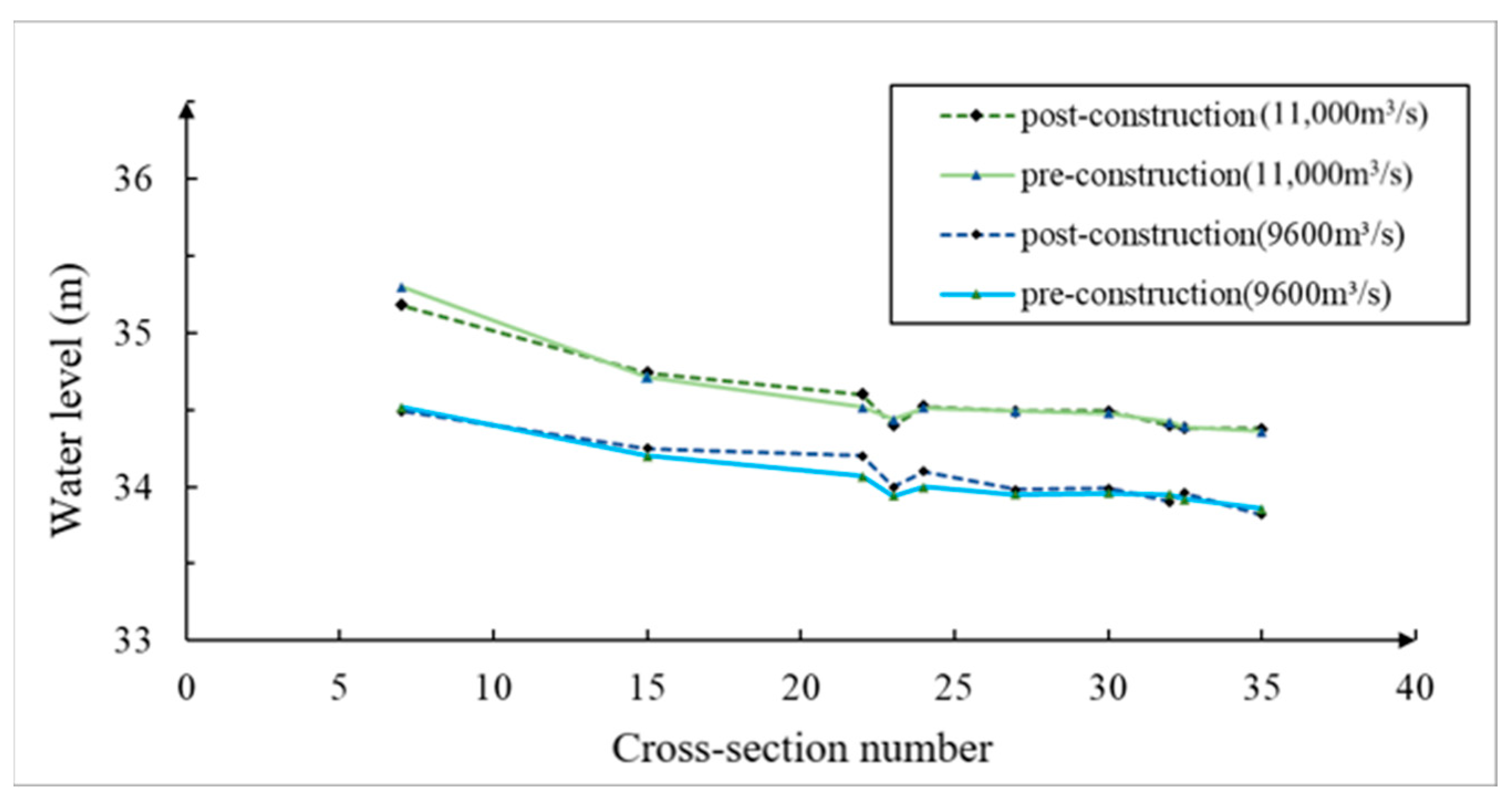


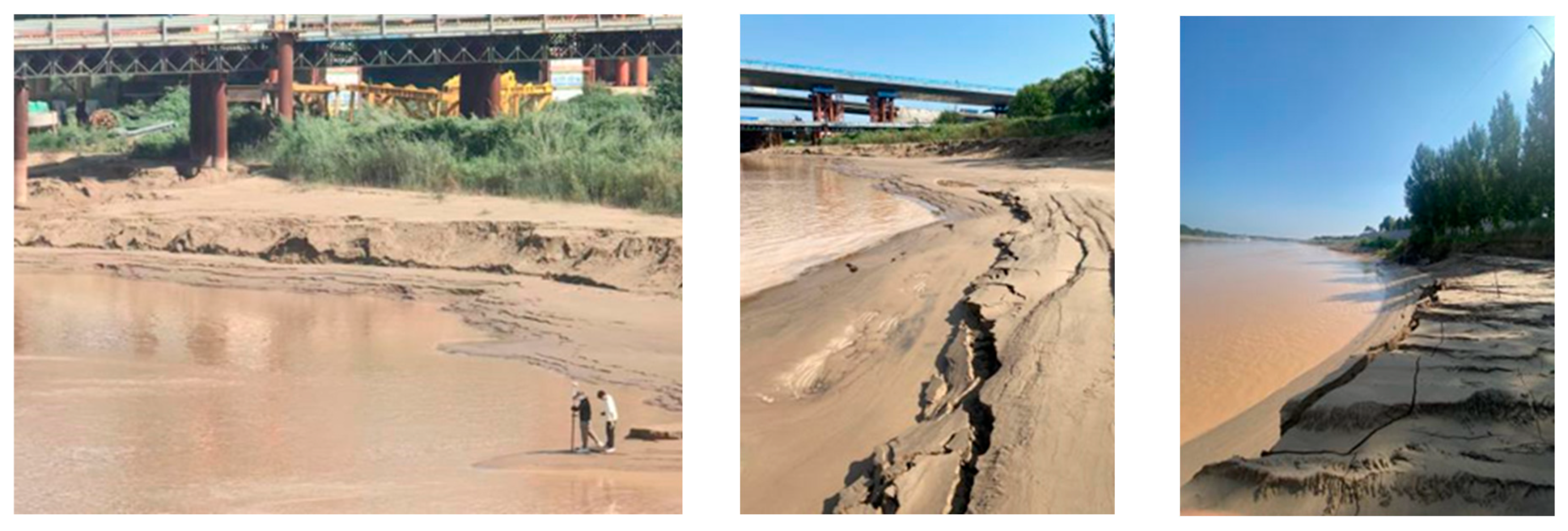



| Item | Name | Construction Time | Number of Spans Within the Dike | Design Standards | |
|---|---|---|---|---|---|
| Discharge (m3/s) | Water Level (m) | ||||
| 1 | Caojiaquan Yellow River Railway Bridge | 1981 | 4 | 11,000 | 39.64 |
| 2 | Jinan Yellow River Bridge of Jingtai Expressway | 1999 | 12 | 11,600 | 41.30 |
| 3 | Jing-Hu High-Speed Railway Yellow River Bridge | 2011 | 4 | 11,000 | 35.35 |
| 4 | Qilu Avenue north extension across the Yellow River Bridge | Under construction | 2 | 11,000 | 38.66 |
| Scale Ratio | Scale Value |
|---|---|
| Horizontal scale | 300 |
| Vertical scale | 60 |
| Velocity scale | 7.75 |
| Roughness scale | 0.88 |
| Discharge scale | 139,500 |
| Flow motion time scale | 38.71 |
| Settling velocity scale | 2.32 |
| Suspended sediment diameter scale | 1.24 |
| Sediment concentration scale | 2.47 |
| Riverbed deformation time scale | 43.55 |
Disclaimer/Publisher’s Note: The statements, opinions and data contained in all publications are solely those of the individual author(s) and contributor(s) and not of MDPI and/or the editor(s). MDPI and/or the editor(s) disclaim responsibility for any injury to people or property resulting from any ideas, methods, instructions or products referred to in the content. |
© 2025 by the authors. Licensee MDPI, Basel, Switzerland. This article is an open access article distributed under the terms and conditions of the Creative Commons Attribution (CC BY) license (https://creativecommons.org/licenses/by/4.0/).
Share and Cite
Zhang, Y.; Chen, B.; Wang, S.; Zhang, X. Physical Model Research on the Impact of Bridge Piers on River Flow in Parallel Bridge Construction Projects. Appl. Sci. 2025, 15, 6581. https://doi.org/10.3390/app15126581
Zhang Y, Chen B, Wang S, Zhang X. Physical Model Research on the Impact of Bridge Piers on River Flow in Parallel Bridge Construction Projects. Applied Sciences. 2025; 15(12):6581. https://doi.org/10.3390/app15126581
Chicago/Turabian StyleZhang, Yu, Bo Chen, Shuo Wang, and Xin Zhang. 2025. "Physical Model Research on the Impact of Bridge Piers on River Flow in Parallel Bridge Construction Projects" Applied Sciences 15, no. 12: 6581. https://doi.org/10.3390/app15126581
APA StyleZhang, Y., Chen, B., Wang, S., & Zhang, X. (2025). Physical Model Research on the Impact of Bridge Piers on River Flow in Parallel Bridge Construction Projects. Applied Sciences, 15(12), 6581. https://doi.org/10.3390/app15126581





